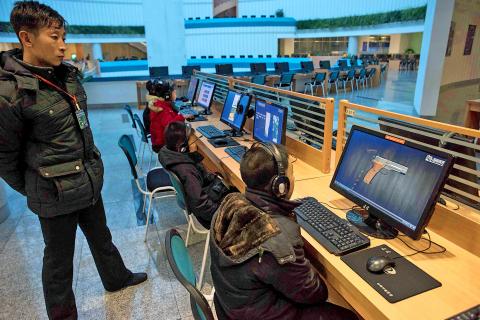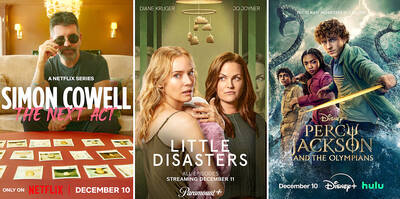In North Korea’s heavily militarized society, even learning the periodic table can be done at the barrel of a gun.
“The young students enjoy it,” said the assistant, picking up a model rifle and aiming it at the familiar table of elements projected on a screen about 10 feet away.
A hit on Po brings up an explanation of Polonium — its discovery, properties and uses.

Photo: AFP/Ed Jones
The shooting range is one of a number of teaching aids housed in the Science and Technology Center, a vast complex built in the shape of an atom on a river islet in Pyongyang.
Opened earlier this year, the center shares characteristics common to other grandiose projects constructed in the showcase capital under the direct orders of supreme leader Kim Jong-un, using scarce money and resources siphoned from North Korea’s threadbare economy.
It was built at lightning speed — just over 10 months using soldier labor — looks impressive, and is almost eerily empty.

Photo: AFP/Ed Jones
The complex reportedly receives several thousand visitors a day, but on a recent Saturday afternoon, only a few dozen of the more than 3,000 computer console study stations were occupied — several of those by members of staff.
Like other prestige projects, the center is as much a symbol of intent as anything else.
WEALTH AND POWER
In numerous speeches and statements, including a keynote address to a rare party congress in May, Kim has put science and technology front and center of the effort to build a “rich and powerful fatherland.”
The power element is firmly focused on national defense, and a science-based weapons system ranging from cyber warfare to a sophisticated nuclear deterrent.
The country’s nuclear and missile scientists are treated as national heroes, feted with personal congratulations from the top leadership and rewarded with modern high-rise apartments in Pyongyang and multiple other benefits for themselves and their families.
The Sci-Tech Center’s main structure is built around a large mock-up of the North’s Unha 3 rocket — a satellite launcher seen as a prototype for an eventual inter-continental ballistic missile capable of delivering a nuclear warhead to the mainland United States.
Pyongyang insists the rocket’s uses are purely scientific and space-based.
On the cyber warfare front, the North has already proved its technical capabilities, launching a damaging attack on South Korean banks and broadcasters in 2013 and blamed by Washington for an audacious hacking assault on Sony Pictures the following year.
‘WORLD-CLASS’ CYBER WARRIORS
In testimony to the US Senate Armed Services Committee in April, the newly-appointed commander of US forces in South Korea, General Vincent Brooks, said the North’s elite cyber units “are among the best in the world and the best organized.”
This in a country where access to the full internet is the privilege of an elite few.
The Sci-Tech complex’s computer consoles are segregated, with those in the main hall only capable of accessing a home-page hosted on an internal server with a limited menu of subjects ranging from children’ cartoons to educational material.
Users over the age of 17 and with the required permission, can surf the North’s tightly-controlled, closed-network intranet system, allowing access to state media and some officially approved sites.
There are also links to North Korean university e-libraries and large wall posters boast — or at least suggest — the availability of well-known Western scientific databases like Elsevier and Springer.
The intranet runs on an indigenously developed Linux-based operating system, Red Star.
Niklaus Scheiss and Florian Grunow, two German researchers who downloaded and conducted an exhaustive analysis of Red Star, described it as the “wet dream of a surveillance state.”
KEEPING TABS
The system notes and reacts to any attempt to tinker with its core functions and creates tabs, or “watermarks,” on the files of a computer or any USB stick connected to it.
The purpose, Scheiss and Grunow told a conference in Hamburg last year, is to track any user who created, possessed or opened any particular file.
It’s a powerful tool in a country where unauthorized material, including foreign films, news articles or music are often shared illicitly using USB sticks or other data cards.
Visitors to the Sci-Tech center are issued temporary ID cards that allocate and log them in and out of a specific console.
“It’s a good place to study and I work here during my lunch breaks,” said Ri Yong-hwa, a college student with a part-time job at the center.
“I wanted to put into action our Dear Leader’s words to place our country at the forefront of science and technology,” Ri told AFP.
Ordinary North Koreans usually express only officially-sanctioned views when questioned by foreign news organizations.

Last week writer Wei Lingling (魏玲靈) unloaded a remarkably conventional pro-China column in the Wall Street Journal (“From Bush’s Rebuke to Trump’s Whisper: Navigating a Geopolitical Flashpoint,” Dec 2, 2025). Wei alleged that in a phone call, US President Donald Trump advised Japanese Prime Minister Sanae Takaichi not to provoke the People’s Republic of China (PRC) over Taiwan. Wei’s claim was categorically denied by Japanese government sources. Trump’s call to Takaichi, Wei said, was just like the moment in 2003 when former US president George Bush stood next to former Chinese premier Wen Jia-bao (溫家寶) and criticized former president Chen

As I finally slid into the warm embrace of the hot, clifftop pool, it was a serene moment of reflection. The sound of the river reflected off the cave walls, the white of our camping lights reflected off the dark, shimmering surface of the water, and I reflected on how fortunate I was to be here. After all, the beautiful walk through narrow canyons that had brought us here had been inaccessible for five years — and will be again soon. The day had started at the Huisun Forest Area (惠蓀林場), at the end of Nantou County Route 80, north and east

A six-episode, behind-the-scenes Disney+ docuseries about Taylor Swift’s Eras Tour and Rian Johnson’s third Knives Out movie, Wake Up Dead Man, are some of the new television, films, music and games headed to a device near you. Also among the streaming offerings worth your time this week: Chip and Joanna Gaines take on a big job revamping a small home in the mountains of Colorado, video gamers can skateboard through hell in Sam Eng’s Skate Story and Rob Reiner gets the band back together for Spinal Tap II: The End Continues. MOVIES ■ Rian Johnson’s third Knives Out movie, Wake Up Dead Man

Politics throughout most of the world are viewed through a left/right lens. People from outside Taiwan regularly try to understand politics here through that lens, especially those with strong personal identifications with the left or right in their home countries. It is not helpful. It both misleads and distracts. Taiwan’s politics needs to be understood on its own terms. RISE OF THE DEVELOPMENTAL STATE Arguably, both of the main parties originally leaned left-wing. The Chinese Nationalist Party (KMT) brought together radicals, dissidents and revolutionaries devoted to overthrowing their foreign Manchurian Qing overlords to establish a Chinese republic. Their leader, Sun Yat-sen